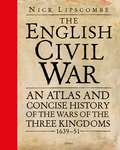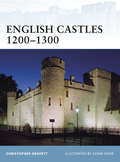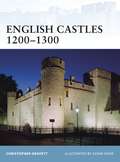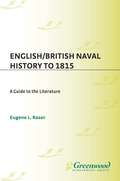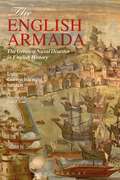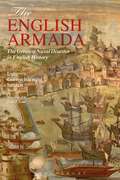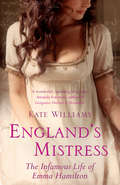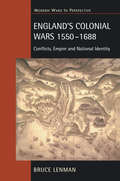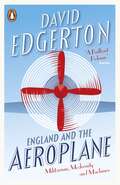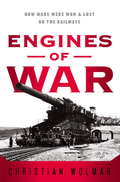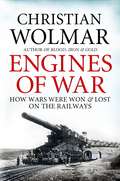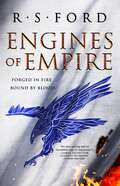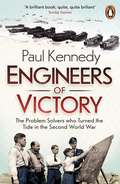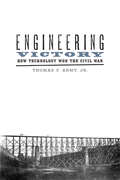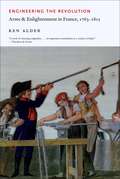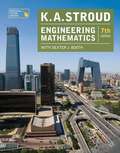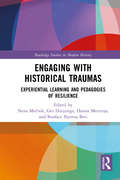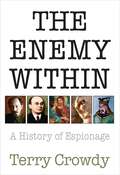- Table View
- List View
The English Civil War: An Atlas and Concise History of the Wars of the Three Kingdoms 1639–51
by Colonel Nick Lipscombe'The English Civil War is a joy to behold, a thing of beauty… this will be the civil war atlas against which all others will judged and the battle maps in particular will quickly become the benchmark for all future civil war maps.' -- Professor Martyn Bennett, Department of History, Languages and Global Studies, Nottingham Trent UniversityThe English Civil Wars (1638–51) comprised the deadliest conflict ever fought on British soil, in which brother took up arms against brother, father fought against son, and towns, cities and villages fortified themselves in the cause of Royalists or Parliamentarians. Although much historical attention has focused on the events in England and the key battles of Edgehill, Marston Moor and Naseby, this was a conflict that engulfed the entirety of the Three Kingdoms and led to a trial and execution that profoundly shaped the British monarchy and Parliament. This beautifully presented atlas tells the whole story of Britain's revolutionary civil war, from the earliest skirmishes of the Bishops' Wars in 1639–40 through to 1651, when Charles II's defeat at Worcester crushed the Royalist cause, leading to a decade of Stuart exile. Each map is supported by a detailed text, providing a complete explanation of the complex and fluctuating conflict that ultimately meant that the Crown would always be answerable to Parliament.
English Castles 1200–1300 (Fortress #86)
by Christopher Gravett Mr Adam HookThe simple castles raised after the Norman conquest had been developed throughout 11th and 12th centuries, whilst the introduction of Islamic and Byzantine fortification techniques from the late 12th century led to further developments in castle architecture. These fortifications were to be well tested throughout the course of the 13th century as England was riven by the conflict, characterized by prolonged sieges, between the monarchy and powerful magnates. As well as providing the focus for warfare, castles increasingly became the centres of their communities, providing a more permanent base for the lord, his family and retainers, as well as acting as centres for justice and administration.
English Castles 1200–1300 (Fortress)
by Adam Hook Christopher GravettThe simple castles raised after the Norman conquest had been developed throughout 11th and 12th centuries, whilst the introduction of Islamic and Byzantine fortification techniques from the late 12th century led to further developments in castle architecture. These fortifications were to be well tested throughout the course of the 13th century as England was riven by the conflict, characterized by prolonged sieges, between the monarchy and powerful magnates. As well as providing the focus for warfare, castles increasingly became the centres of their communities, providing a more permanent base for the lord, his family and retainers, as well as acting as centres for justice and administration.
English/British Naval History to 1815: A Guide to the Literature (Bibliographies and Indexes in Military Studies)
by Eugene L. RasorThe English/British have always been known as the sailor race with hearts of oak: the Royal Navy as the Senior Service and First Line of Defense. It facilitated the motto: The sun never set on the British Empire. The Royal Navy has exerted a powerful influence on Great Britain, its Empire, Europe, and, ultimately, the world. This superior annotated bibliography supplies entries that explore the influence of the English/British Navy through its history.This survey will provide a major reference guide for students and scholars at all levels. It incorporates evaluative, qualitative, and critical analysis processes, the essence of historical scholarship. Each one of the 4,124 annotated entries is evaluated, assessed, analyzed, integrated, and incorporated into the historiographical scholarship.
The English Armada: The Greatest Naval Disaster in English History
by Luis Gorrochategui SantosDuring the year between July 1588, when the Spanish Armada set sail from Spain and July 1589, when the survivors of the English counterpart of this fleet, the little-known English Armada, reached port in England, two of history's worst naval catastrophes took place. A great deal of attention has been dedicated to the former and precious little to the latter. This book presents a full-scale account of an event which has been neglected for more than four centuries. It reconstructs the military operations day by day for the first time, taking apart the established notion that, with the defeat of the Spanish Armada, England achieved maritime supremacy and the decay of Spain began. This book clearly and in a rigorously documented fashion shows how the defeat of the English Armada counterbalanced that of the Spanish, frustrating England's intention of seizing Philip II's American empire and changing the tide of the war.
The English Armada: The Greatest Naval Disaster in English History
by Luis Gorrochategui SantosDuring the year between July 1588, when the Spanish Armada set sail from Spain and July 1589, when the survivors of the English counterpart of this fleet, the little-known English Armada, reached port in England, two of history's worst naval catastrophes took place. A great deal of attention has been dedicated to the former and precious little to the latter. This book presents a full-scale account of an event which has been neglected for more than four centuries. It reconstructs the military operations day by day for the first time, taking apart the established notion that, with the defeat of the Spanish Armada, England achieved maritime supremacy and the decay of Spain began. This book clearly and in a rigorously documented fashion shows how the defeat of the English Armada counterbalanced that of the Spanish, frustrating England's intention of seizing Philip II's American empire and changing the tide of the war.
England's Mistress: The Infamous Life of Emma Hamilton
by Kate WilliamsA dramatic, sparkling tale of sex, glamour, intrigue, romance and heartbreak, England's Mistress traces the rise and rise of the gorgeous Emma Hamilton.Born into poverty, she clawed her way up through London's underworlds of sex for sale to become England's first media superstar. Nothing could stand in the way of her dreams- except her self-destructive desires. Drawing on hundreds of previously undiscovered letters, and told with a novelist's flair, England's Mistress captures the relentless drive, innovative style and burning passion of a true heroine. In a world of tabloid fame and three-minute wonders, Emma's life is truly a tale for our time.
England's Colonial Wars 1550-1688: Conflicts, Empire and National Identity
by Bruce LenmanBruce Lenman's hugely ambitious study explores three interacting themes: the growth of England's sprawling colonial empire; its military dimension; and the impact of colonial warfare on national identity. He starts in Ireland, with the renewed assault of English settlers on the Irish Gaeltacht. Under the (Scottish) Stuarts, England then began a dramatic expansion across the North Atlantic. In America, the 'Indian Wars', fought with minimal Crown support, helped forge an independent military capability among the colonists; while, in the West Indies, slave numbers and French intervention forced English settlers into a new dependency on the Crown. In India, the East India Company achieved ascendancy by sepoy armies under British control. These were very different kinds of empire; and a showdown became inevitable. The climactic conflict, the American Revolution, would not only dictate the future shape of colonial expansion, but also decisively reshaped the identities of all the participants.
England's Colonial Wars 1550-1688: Conflicts, Empire and National Identity
by Bruce LenmanBruce Lenman's hugely ambitious study explores three interacting themes: the growth of England's sprawling colonial empire; its military dimension; and the impact of colonial warfare on national identity. He starts in Ireland, with the renewed assault of English settlers on the Irish Gaeltacht. Under the (Scottish) Stuarts, England then began a dramatic expansion across the North Atlantic. In America, the 'Indian Wars', fought with minimal Crown support, helped forge an independent military capability among the colonists; while, in the West Indies, slave numbers and French intervention forced English settlers into a new dependency on the Crown. In India, the East India Company achieved ascendancy by sepoy armies under British control. These were very different kinds of empire; and a showdown became inevitable. The climactic conflict, the American Revolution, would not only dictate the future shape of colonial expansion, but also decisively reshaped the identities of all the participants.
England and the Aeroplane: Militarism, Modernity and Machines
by David EdgertonThe story of the strange mixture of romanticism, militarism and technology that has made planes so important to England, from the brilliant author of Britain's War MachineThe history of England and the aeroplane is one tangled with myths - of 'the Few' and the Blitz, of boffins, flying machines, amateur inventors and muddling through. In England and the Aeroplane David Edgerton reverses received wisdom, showing that the aeroplane is a central and revealing aspect of an unfamiliar English nation: a warfare state dedicated to technology, industry, empire and military power.England had the strongest air force in the Great War, the largest industry in the world in the 1920s, outproduced Germany by 50% at the time of the Battle of Britain and was the third largest producers of aeroplanes well after this time. In a revelatory recounting of the story of aeronautical England, from its politics to its industry and culture, David Edgerton reconfigures some of the most important chapters of our history.Reviews:'A brilliant polemic' Guardian'Full of good stories ... an illuminating read' Spectator'A tour de force, after which the history of the aircraft industry will never be quite the same again' Business History'David Edgerton's sure-footed essay ... sees Britain from an unusual perspective ... His arguments provide sound backing for the idea that modern Britain is as much a warfare state as a welfare one' EconomistAbout the author:David Edgerton is Hans Rausing Professor at Imperial College London, where he was the founding director of the Centre for the History of Science, Technology and Medicine. He is the author of a sequence of groundbreaking books on 20th century Britain: Science, Technology and the British Industrial 'Decline', 1870-1970; Warfare State: Britain, 1920-1970; and Britain's War Machine, published by Penguin. He is also the author of the iconoclastic and brilliant The Shock of the Old: Technology and Global History Since 1900.
Engines of War: How Wars Were Won & Lost on the Railways
by Christian WolmarBefore the nineteenth century, armies had to rely on slow and unreliable methods of transportation to move soldiers and equipment during times of conflict. But with the birth of the railroad in the early 1830s, the way wars were fought would change forever. In Engines of War, renowned expert Christian Wolmar tells the story of that transformation, examining all the engagements in which railways played a part from the Crimean War and American Civil War through both world wars, the Korean War, and the Cold War with its mysterious missile trains. He shows that the 'iron road' not only made armies far more mobile, but also greatly increased the scale and power of available weaponry. Wars began to be fought across wider fronts and over longer timescales, with far deadlier consequences. From armored engines with their swiveling guns to track sabotage by way of dynamite, railway lines constructed across frozen Siberian lakes and a Boer war ambush involving Winston Churchill, Engines of War shows how the railways - a fantastic generator of wealth in peacetime - became a weapon of war exploited to the full by governments across the world.
Engines of War: How Wars Were Won and Lost on the Railways
by Christian WolmarEngines of War tells the dramatic story of how the railways revolutionized the nature of warfare, ushering in an age of industrialized conflict in which wars were fought on a previously unimaginable scale. From the moment of its first appearance, the 'iron road' not only rendered armies more mobile, but also massively increased the power and the deadliness of the weaponry available to them. Christian Wolmar's epic account of how an invention that brought prosperity in peace-time metamorphosed in time of war into a weapon of death, is counterpointed by a wealth of human stories of personal endeavour and private tragedy. Embracing every major conflict in which railways have played a part - the Crimean War, the American Civil War, the First and Second Boer Wars, the two World Wars, the Korean War and the Cold War, Engines of War is awe-inspiring tale of industrial might and the transformative power of machinery.
Engines of Empire (The Age of Uprising #1)
by R. S. Ford"Perfect for fans of Brent Weeks, George R. R. Martin, or David Gemmell . . . . The best traditional epic fantasy I have read in years." — Grimdark Magazine &“Epic fantasy fans listen up: This is the good stuff. Highly recommended.&” — Kirkus (starred review) FORGED IN FIRE, BOUND BY BLOOD. From an unmissable voice in epic fantasy comes a sweeping tale of clashing guilds, magic-fueled machines, and revolution. The nation of Torwyn is run on the power of industry, and industry is run by the Guilds. Chief among them are the Hawkspurs, whose responsibility it is to keep the gears of the empire turning. That&’s exactly why matriarch Rosomon Hawkspur sends each of her heirs to the far reaches of the nation. Conall, the eldest son, is sent to the distant frontier to earn his stripes in the military. It is here that he faces a threat he could have never seen coming: the first rumblings of revolution. Tyreta is a sorceress with the ability to channel the power of pyrestone, the magical resource that fuels the empire&’s machines. She is sent to the mines to learn more about how pyrsetone is harvested – but instead, she finds the dark horrors of industry that the empire would prefer to keep hidden. The youngest, Fulren, is a talented artificer and finds himself acting as a guide to a mysterious foreign emissary. Soon after, he is framed for a crime he never committed. A crime that could start a war. As the Hawkspurs grapple with the many threats that face the nation within and without, they must finally prove themselves worthy–or their empire will fall apart. &“An epic setting, and an incredible cast of characters.&” – James Islington, author of The Shadow of What Was Lost
Engineers of Victory: The Problem Solvers who Turned the Tide in the Second World War
by Paul KennedyFrom Paul Kennedy, author of The Rise and Fall of the Great Powers, one of the most acclaimed history books of recent decades, Engineers of Victory is a new account of how the tide was turned against the Nazis by the Allies in the Second World War. In January 1943 Churchill and Roosevelt and the Combined Chiefs of Staff met in Casablanca to review the western Allies' war aims and strategy. They realised that to attain their ultimate aim of 'unconditional surrender' they would have to achieve some formidable objectives - win control of the Atlantic sea-lanes and command of the air over the whole of West-Central Europe, work out how to land on an enemy-held shore so that Continental Europe could be retaken, how to blunt the Nazi blitzkrieg that a successful invasion would undoubtedly provoke, and finally how to 'hop' across the islands of the Pacific to assault the Japanese mainland. Eighteen months later on, as Paul Kennedy writes, 'these operational aims were either accomplished or close to being so.' The history of the Second World War is often told as a grand narrative. The focus of this book, by contrast, is on the problem-solvers - Major-General Perry Hobart, who invented the 'funny tanks' which flattened the curve on the D-Day beaches; Flight Lieutenant Ronnie Harker 'the man who put the Merlin in the Mustang'; Captain 'Johnny' Walker, the convoy captain who worked out how to sink U-boats with a 'creeping barrage'. The result is a fresh perspective on the greatest, conflict in human history.Paul Kennedy is one of the world's best-selling and most influential historians. He is the author or editor of nineteen books, including The Rise and Fall of the Great Powers, which has been translated into over twenty languages, Preparing for the Twenty-First Century, The Parliament of Man and the now classic Rise and Fall of British Naval Mastery.
Engineering Victory: How Technology Won the Civil War (Johns Hopkins Studies in the History of Technology)
by Thomas F. Army Jr.Engineering Victory brings a fresh approach to the question of why the North prevailed in the Civil War. Historian Thomas F. Army, Jr., identifies strength in engineering;¢;‚¬;€?not superior military strategy or industrial advantage;¢;‚¬;€?as the critical determining factor in the war;€™s outcome.Army finds that Union soldiers were able to apply scientific ingenuity and innovation to complex problems in a way that Confederate soldiers simply could not match. Skilled Free State engineers who were trained during the antebellum period benefited from basic educational reforms, the spread of informal educational practices, and a culture that encouraged learning and innovation. During the war, their rapid construction and repair of roads, railways, and bridges allowed Northern troops to pass quickly through the forbidding terrain of the South as retreating and maneuvering Confederates struggled to cut supply lines and stop the Yankees from pressing any advantage.By presenting detailed case studies from both theaters of the war, Army clearly demonstrates how the soldiers;€™ education, training, and talents spelled the difference between success and failure, victory and defeat. He also reveals massive logistical operations as critical in determining the war;€™s outcome.
Engineering Victory: How Technology Won the Civil War (Johns Hopkins Studies in the History of Technology)
by Thomas F. Army Jr.Engineering Victory brings a fresh approach to the question of why the North prevailed in the Civil War. Historian Thomas F. Army, Jr., identifies strength in engineering;¢;‚¬;€?not superior military strategy or industrial advantage;¢;‚¬;€?as the critical determining factor in the war;€™s outcome.Army finds that Union soldiers were able to apply scientific ingenuity and innovation to complex problems in a way that Confederate soldiers simply could not match. Skilled Free State engineers who were trained during the antebellum period benefited from basic educational reforms, the spread of informal educational practices, and a culture that encouraged learning and innovation. During the war, their rapid construction and repair of roads, railways, and bridges allowed Northern troops to pass quickly through the forbidding terrain of the South as retreating and maneuvering Confederates struggled to cut supply lines and stop the Yankees from pressing any advantage.By presenting detailed case studies from both theaters of the war, Army clearly demonstrates how the soldiers;€™ education, training, and talents spelled the difference between success and failure, victory and defeat. He also reveals massive logistical operations as critical in determining the war;€™s outcome.
Engineering the Revolution: Arms and Enlightenment in France, 1763-1815 (Princeton Legacy Library)
by Ken AlderEngineering the Revolution documents the forging of a new relationship between technology and politics in Revolutionary France, and the inauguration of a distinctively modern form of the “technological life.” Here, Ken Alder rewrites the history of the eighteenth century as the total history of one particular artifact—the gun—by offering a novel and historical account of how material artifacts emerge as the outcome of political struggle. By expanding the “political” to include conflict over material objects, this volume rethinks the nature of engineering rationality, the origins of mass production, the rise of meritocracy, and our interpretation of the Enlightenment and the French Revolution.
Engineering the Revolution: Arms and Enlightenment in France, 1763-1815 (Princeton Legacy Library)
by Ken AlderEngineering the Revolution documents the forging of a new relationship between technology and politics in Revolutionary France, and the inauguration of a distinctively modern form of the “technological life.” Here, Ken Alder rewrites the history of the eighteenth century as the total history of one particular artifact—the gun—by offering a novel and historical account of how material artifacts emerge as the outcome of political struggle. By expanding the “political” to include conflict over material objects, this volume rethinks the nature of engineering rationality, the origins of mass production, the rise of meritocracy, and our interpretation of the Enlightenment and the French Revolution.
Engineering the Revolution: Arms and Enlightenment in France, 1763-1815
by Ken AlderEngineering the Revolution documents the forging of a new relationship between technology and politics in Revolutionary France, and the inauguration of a distinctively modern form of the “technological life.” Here, Ken Alder rewrites the history of the eighteenth century as the total history of one particular artifact—the gun—by offering a novel and historical account of how material artifacts emerge as the outcome of political struggle. By expanding the “political” to include conflict over material objects, this volume rethinks the nature of engineering rationality, the origins of mass production, the rise of meritocracy, and our interpretation of the Enlightenment and the French Revolution.
Engineering the Revolution: Arms and Enlightenment in France, 1763-1815
by Ken AlderEngineering the Revolution documents the forging of a new relationship between technology and politics in Revolutionary France, and the inauguration of a distinctively modern form of the “technological life.” Here, Ken Alder rewrites the history of the eighteenth century as the total history of one particular artifact—the gun—by offering a novel and historical account of how material artifacts emerge as the outcome of political struggle. By expanding the “political” to include conflict over material objects, this volume rethinks the nature of engineering rationality, the origins of mass production, the rise of meritocracy, and our interpretation of the Enlightenment and the French Revolution.
Engineering Mathematics (PDF)
by K. A. StroudEngineering Mathematics is the best-selling introductory mathematics text for students on science and engineering degree and pre-degree courses. Sales of previous editions stand at more than half a million copies. It is suitable for classroom use and self-study. Its unique programmed approach takes students through the mathematics they need in a step-by-step fashion with a wealth of examples and exercises. The book is divided into two sections with the Foundation section starting at Level 0 of the IEng syllabus and the main section extending over all elements of a first year undergraduate course and into many second year courses. The book therefore suits a full range of abilities and levels of access. The Online Personal Tutor guides students through exercises in the same step-by-step fashion as the book, with hundreds of full workings to questions.
Engaging with Historical Traumas: Experiential Learning and Pedagogies of Resilience (Routledge Studies in Modern History)
by Nena Mo 269 Nik Ger Duijzings Hanna Meretoja Bonface Njeresa BetiThis book provides case-studies of how teachers and practitioners have attempted to develop more effective ‘experiential learning’ strategies in order to better equip students for their voluntary engagements in communities, working for sustainable peace and a tolerant society free of discrimination. All chapters revolve around this central theme, testing and trying various paradigms and experimenting with different practices, in a wide range of geographical and historical arenas. They demonstrate the innovative potentials of connecting know-how from different disciplines and combining experiences from various practitioners in this field of shaping historical memory, including non-formal and formal sectors of education, non-governmental workers, professionals from memorial sites and museums, local and global activists, artists, and engaged individuals. In so doing, they address the topic of collective historical traumas in ways that go beyond conventional classroom methods. Interdisciplinary in approach, the book provides a combination of theoretical reflections and concrete pedagogical suggestions that will appeal to educators working across history, sociology, political science, peace education and civil awareness education, as well as memory activists and remembrance practitioners.
Engaging with Historical Traumas: Experiential Learning and Pedagogies of Resilience (Routledge Studies in Modern History)
by Nena MočnikThis book provides case-studies of how teachers and practitioners have attempted to develop more effective ‘experiential learning’ strategies in order to better equip students for their voluntary engagements in communities, working for sustainable peace and a tolerant society free of discrimination. All chapters revolve around this central theme, testing and trying various paradigms and experimenting with different practices, in a wide range of geographical and historical arenas. They demonstrate the innovative potentials of connecting know-how from different disciplines and combining experiences from various practitioners in this field of shaping historical memory, including non-formal and formal sectors of education, non-governmental workers, professionals from memorial sites and museums, local and global activists, artists, and engaged individuals. In so doing, they address the topic of collective historical traumas in ways that go beyond conventional classroom methods. Interdisciplinary in approach, the book provides a combination of theoretical reflections and concrete pedagogical suggestions that will appeal to educators working across history, sociology, political science, peace education and civil awareness education, as well as memory activists and remembrance practitioners.
The Enemy Within: A History of Spies, Spymasters and Espionage
by Terry CrowdySeparating myth from reality, The Enemy Within traces the history of espionage from its development in ancient times through to the end of the Cold War and beyond, shedding light on the clandestine activities that have so often tipped the balance in times of war. This detailed account delves into the murky depths of the realm of spymasters and their spies, revealing many amazing and often bizarre stories along the way. From the monkey hanged as a spy during the Napoleonic wars to the British Double Cross Committee in World War II, this journey through the history of espionage shows us that no two spies are alike and their fascinating stories are fraught with danger and intrigue.
The Enemy Within: A History of Spies, Spymasters and Espionage (General Military Ser.)
by Terry CrowdySeparating myth from reality, The Enemy Within traces the history of espionage from its development in ancient times through to the end of the Cold War and beyond, shedding light on the clandestine activities that have so often tipped the balance in times of war. This detailed account delves into the murky depths of the realm of spymasters and their spies, revealing many amazing and often bizarre stories along the way. From the monkey hanged as a spy during the Napoleonic wars to the British Double Cross Committee in World War II, this journey through the history of espionage shows us that no two spies are alike and their fascinating stories are fraught with danger and intrigue.
